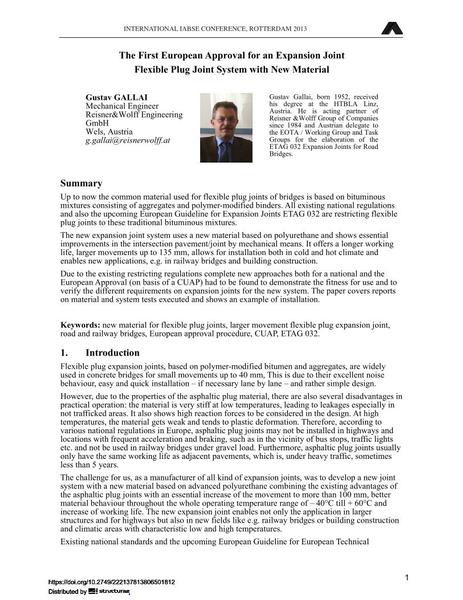The First European Approval for an Expansion Joint Flexible Plug Joint System with New Material

|
|
|||||||||||
Bibliografische Angaben
| Autor(en): |
Gustav Gallai
|
||||
|---|---|---|---|---|---|
| Medium: | Tagungsbeitrag | ||||
| Sprache(n): | Englisch | ||||
| Tagung: | IABSE Conference: Assessment, Upgrading and Refurbishment of Infrastructures, Rotterdam, The Netherlands, 6-8 May 2013 | ||||
| Veröffentlicht in: | IABSE Conference, Rotterdam, May 2013 | ||||
|
|||||
| Seite(n): | 402-403 | ||||
| Anzahl der Seiten (im PDF): | 8 | ||||
| Jahr: | 2013 | ||||
| DOI: | 10.2749/222137813806501812 | ||||
| Abstrakt: |
Up to now the common material used for flexible plug joints of bridges is based on bituminous mixtures consisting of aggregates and polymer-modified binders. All existing national regulations and also the upcoming European Guideline for Expansion Joints ETAG 032 are restricting flexible plug joints to these traditional bituminous mixtures. The new expansion joint system uses a new material based on polyurethane and shows essential improvements in the intersection pavement/joint by mechanical means. It offers a longer working life, larger movements up to 135 mm, allows for installation both in cold and hot climate and enables new applications, e.g. in railway bridges and building construction. Due to the existing restricting regulations complete new approaches both for a national and the European Approval (on basis of a CUAP) had to be found to demonstrate the fitness for use and to verify the different requirements on expansion joints for the new system. The paper covers reports on material and system tests executed and shows an example of installation. |
||||
